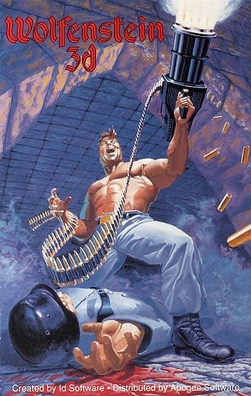
Wolfenstein 3D is a first-person shooter video game developed by id Software and published by Apogee Software and FormGen. Originally released on May 5, 1992, for DOS, it was inspired by the 1981 Muse Software video game Castle Wolfenstein, and is the third installment in the Wolfenstein series. In Wolfenstein 3D, the player assumes the role of Allied spy William "B.J." Blazkowicz during World War II as he escapes from the Nazi German prison Castle Wolfenstein and carries out a series of crucial missions against the Nazis. The player traverses each of the game's levels to find an elevator to the next level or kill a final boss, fighting Nazi soldiers, dogs, and other enemies with a knife and a variety of guns.
Commander Keen is a series of side-scrolling platform video games developed primarily by id Software. The series consists of six main episodes, a "lost" episode, and a final game; all but the final game were released for MS-DOS in 1990 and 1991, while the 2001 Commander Keen was released for the Game Boy Color. The series follows the eponymous Commander Keen, the secret identity of the eight-year-old genius Billy Blaze, as he defends the Earth and the galaxy from alien threats with his homemade spaceship, rayguns, and pogo stick. The first three episodes were developed by Ideas from the Deep, the precursor to id, and published by Apogee Software as the shareware title Commander Keen in Invasion of the Vorticons; the "lost" episode 3.5 Commander Keen in Keen Dreams was developed by id and published as a retail title by Softdisk; episodes four and five were released by Apogee as the shareware Commander Keen in Goodbye, Galaxy; and the simultaneously developed episode six was published in retail by FormGen as Commander Keen in Aliens Ate My Babysitter. Ten years later, an homage and sequel to the series was developed by David A. Palmer Productions and published by Activision as Commander Keen. Another game was announced in 2019 as under development by ZeniMax Online Studios, but was not released.
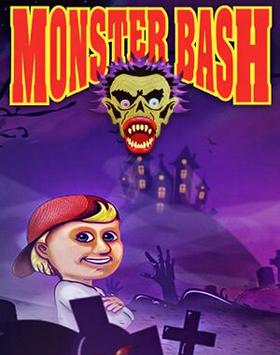
Monster Bash is a side-scrolling platform game developed and published by Apogee Software on 9 April 1993 for DOS. The game features 16-color EGA graphics and IMF AdLib compatible music. It was developed by Frank Maddin and Gerald Lindsly.
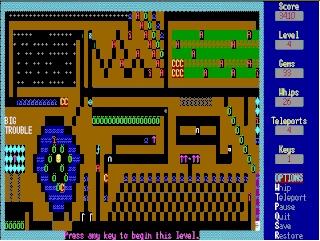
Kroz is a series of Roguelike video games created by Scott Miller for IBM PC compatibles. The first episode in the series, Kingdom of Kroz, was released in 1987 as Apogee Software's first game. It was also published on Big Blue Disk #20. Kroz introduced the scheme of the first episode being free and charging money for additional episodes, a technique which defined the business model for Apogee and was adopted by other MS-DOS shareware publishers.
Scott Miller is an American video game designer, programmer, and entrepreneur best known for founding Apogee Software, Ltd. in 1987. Starting with the Kroz series for MS-DOS from that year, Miller pioneered the concept of giving away the first game in a trilogy—distributed freely as shareware—with the opportunity to purchase the remaining two episodes. This method became the standard distribution method for Apogee. Competitors such as Epic MegaGames later adopted the same business model.
Word Rescue is an educational platform DOS game written by Karen Crowther (Chun) of Redwood Games and released by Apogee Software in March 1992. It was re-released in 2015 for Steam with support for Windows and Mac OS. The game can also allow the player interact with a pair of Stereoscopic Vision Glasses.

Bio Menace is a 1993 game developed and published by Apogee Software for MS-DOS. A 2D multidirectional scrolling platform game, it was built on a licensed version of id Software's Commander Keen game engine. Apart from the engine and music, all in-game content was created by the game's designer, Jim Norwood. In 2014, the game was re-released on Steam, and in 2015 on GOG.com with support for Microsoft Windows, macOS, and Linux.
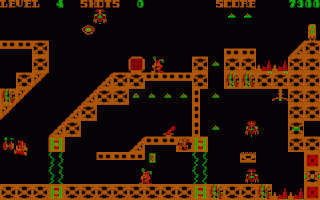
Monuments of Mars is a third-person puzzle-platform game developed by Scenario Software for MS-DOS and compatible systems. It was published by Apogee Software. The game consists of four 20-level episodes, the first episode being shareware, the rest being commercial software. It is similar to the games Arctic Adventure and Pharaoh's Tomb but uses an unrelated engine.

Boppin' is a puzzle-oriented video game created by Jennifer Diane Reitz in 1991, developed under the company name Accursed Toys and published by Karmasoft for the Amiga computer. Around that time Karmasoft held a level design contest. The game sold poorly with 284 copies, so Jennifer got it republished by Apogee Software with up to 256 colors on screen. Due to mature content containing blood and seppuku, Apogee included a disclaimer in the manual that the game contained potentially offensive imagery, as well as part of a manifesto from Accursed Toys stating that their games were produced for an audience of adult gamers who are mostly 25 and older.

Alien Carnage, originally released as Halloween Harry, is a side-scrolling platform game developed by Interactive Binary Illusions and SubZero Software, and distributed by Apogee Software. The game features 256-colour VGA graphics and background music in MOD format. Alien Carnage is composed of four episodes. The first episode was released as shareware, and the rest were distributed commercially. In May 2007, John Passfield and 3D Realms released Alien Carnage as freeware. In 2014, the game was re-released with Windows support.

Arctic Adventure is a platform game written for DOS, published by Apogee Software. It is the sequel to Pharaoh's Tomb. The protagonist, Nevada Smith, is an archaeologist searching for a Viking treasure in the Arctic. It was re-released on Steam in 2015 with support for Windows and macOS.

Dark Ages is a platform game written for MS-DOS, published by Apogee Software. It was the first shareware game to feature music for the AdLib sound card.
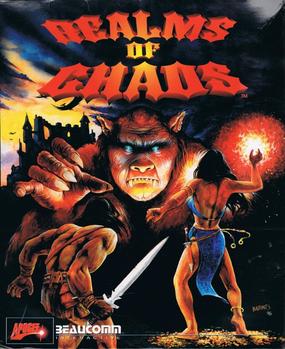
Realms of Chaos is a platform game written for DOS, published by Apogee Software as shareware in November 1995, with the full version released later that month. The game was authored by Keith Schuler, who had previously designed Paganitzu, and was originally to be a sequel entitled Alabama Smith and the Bloodfire Pendant. It is still sold by Apogee. Like previous platform Apogee games, this one utilized the FAST engine. The game was re-released in 2013 on GOG.com with support for Windows, macOS, and Linux.
Pickle Wars is an MS-DOS platform game created in 1993 by Karen Crowther through Redwood Games and published by MVP Software. A planet gets invaded by pickles. The player goes on a journey to find hidden weapons. The player needs to collect all the SaladShooters in the level to pass through the exit door. The player can then shoot salad at the aliens, and the aliens will faint. Junk food and pickles are collectible for points, and carrots are for health.

Commander Keen in Invasion of the Vorticons is a three-part episodic side-scrolling platform video game developed by Ideas from the Deep and published by Apogee Software in 1990 for MS-DOS. It is the first set of episodes of the Commander Keen series. The game follows the titular Commander Keen, an eight-year-old child genius, as he retrieves the stolen parts of his spaceship from the cities of Mars, prevents a recently arrived alien mothership from destroying landmarks on Earth, and hunts down the leader of the aliens, the Grand Intellect, on the alien home planet. The three episodes feature Keen running, jumping, and shooting through various levels while opposed by aliens, robots, and other hazards.

Commander Keen in Goodbye, Galaxy is a two-part episodic side-scrolling platform video game developed by id Software and published by Apogee Software in 1991 for DOS. It consists of the fifth and sixth episodes of the Commander Keen series, though they are numbered as the fourth and fifth, as Commander Keen in Keen Dreams is not part of the main continuity. The game follows the titular Commander Keen, an eight-year-old child genius, as he first journeys through the Shadowlands to rescue the Gnosticenes so they may ask the Oracle how the Shikadi plan to destroy the galaxy, and then through the Shikadi's Armageddon Machine to stop them. The two episodes feature Keen running, jumping, and shooting through various levels while opposed by aliens, robots, and other hazards.

Commander Keen in Aliens Ate My Babysitter is a side-scrolling platform video game developed by id Software and published by FormGen in December 1991 for DOS. It is the seventh episode of the Commander Keen series, though it is numbered as the sixth, as Commander Keen in Keen Dreams is outside of the main continuity. The game follows the titular Commander Keen, an eight-year-old child genius, as he journeys through an alien world to rescue his kidnapped babysitter. The game features Keen running, jumping, and shooting through various levels while opposed by aliens, robots, and other hazards.
Karen Chun is an American computer game designer and programmer. The president of Redwood Games, she has created educational games including Math Rescue, Word Rescue, as well as the game Pickle Wars.













